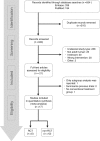Effects of Polymyxin B Hemoperfusion on Mortality in Patients With Severe Sepsis and Septic Shock: A Systemic Review, Meta-Analysis Update, and Disease Severity Subgroup Meta-Analysis
- PMID: 28445237
- PMCID: PMC5515642
- DOI: 10.1097/CCM.0000000000002362
Effects of Polymyxin B Hemoperfusion on Mortality in Patients With Severe Sepsis and Septic Shock: A Systemic Review, Meta-Analysis Update, and Disease Severity Subgroup Meta-Analysis
Abstract
Objective: Several studies have reported a survival benefit for polymyxin B hemoperfusion treatment in patients with severe sepsis and septic shock. However, recently, a propensity-matched analysis and a randomized controlled trial reported no survival benefit for polymyxin B hemoperfusion treatment. We performed an up-to-date meta-analysis to determine the effect of polymyxin B hemoperfusion treatment on mortality in patients with severe sepsis and septic shock.
Data sources: PubMed, Embase, and Cochrane Library were searched from inception to May 2016.
Study selection: Studies investigating the effect of polymyxin B hemoperfusion on mortality were considered eligible. We searched for terms related to severe sepsis and septic shock and terms related to polymyxin B hemoperfusion.
Data extraction: The following data were extracted from the original articles: the name of the first author and publication year, subjects and setting, inclusion and exclusion criteria, mean age and size of the study population, male percentage, mortality, blood pressure, Sequential Organ Failure Assessment score, pulmonary oxygenation, and levels of endotoxin and humoral cytokines.
Data synthesis: A total of 17 trials were included. The pooled risk ratio for overall mortality was 0.81 (95% CI, 0.70-0.95), favoring polymyxin B hemoperfusion (p = 0.007). Disease severity subgroup meta-analysis revealed a significant reduction of mortality in the intermediate- and high-risk groups (risk ratio, 0.84; 95% CI, 0.77-0.92 and risk ratio, 0.64; 95% CI, 0.52-0.78, respectively), but not in the low-risk group (risk ratio, 1.278; 95% CI, 0.888-1.839). The nonlinear meta-regression with restricted cubic spline showed an almost linear inverse association between the baseline mortality rate and reduction in the risk of mortality.
Conclusion: The present study demonstrated that polymyxin B hemoperfusion treatment may reduce mortality in patients with severe sepsis and septic shock in specific disease severity subgroups.
Conflict of interest statement
The authors have disclosed that they do not have any potential conflicts of interest.
Figures




References
-
- American College of Chest Physicians/Society of Critical Care Medicine Consensus Conference: Definitions for sepsis and organ failure and guidelines for the use of innovative therapies in sepsis. Crit Care Med 1992; 20:864–874.. - PubMed
-
- Heumann D, Glauser MP, Calandra T. Molecular basis of host-pathogen interaction in septic shock. Curr Opin Microbiol 1998; 1:49–55.. - PubMed
-
- Danner RL, Elin RJ, Hosseini JM, et al. Endotoxemia in human septic shock. Chest 1991; 99:169–175.. - PubMed
-
- Davies B, Cohen J. Endotoxin removal devices for the treatment of sepsis and septic shock. Lancet Infect Dis 2011; 11:65–71.. - PubMed
-
- Hanasawa K, Tani T, Oka T, et al. Selective removal of endotoxin from the blood by extracorporeal hemoperfusion with polymyxin B immobilized fiber. Prog Clin Biol Res 1988; 264:337–341.. - PubMed
Publication types
MeSH terms
Substances
LinkOut - more resources
Full Text Sources
Other Literature Sources
Medical

